AEG EWD1477 User Manual
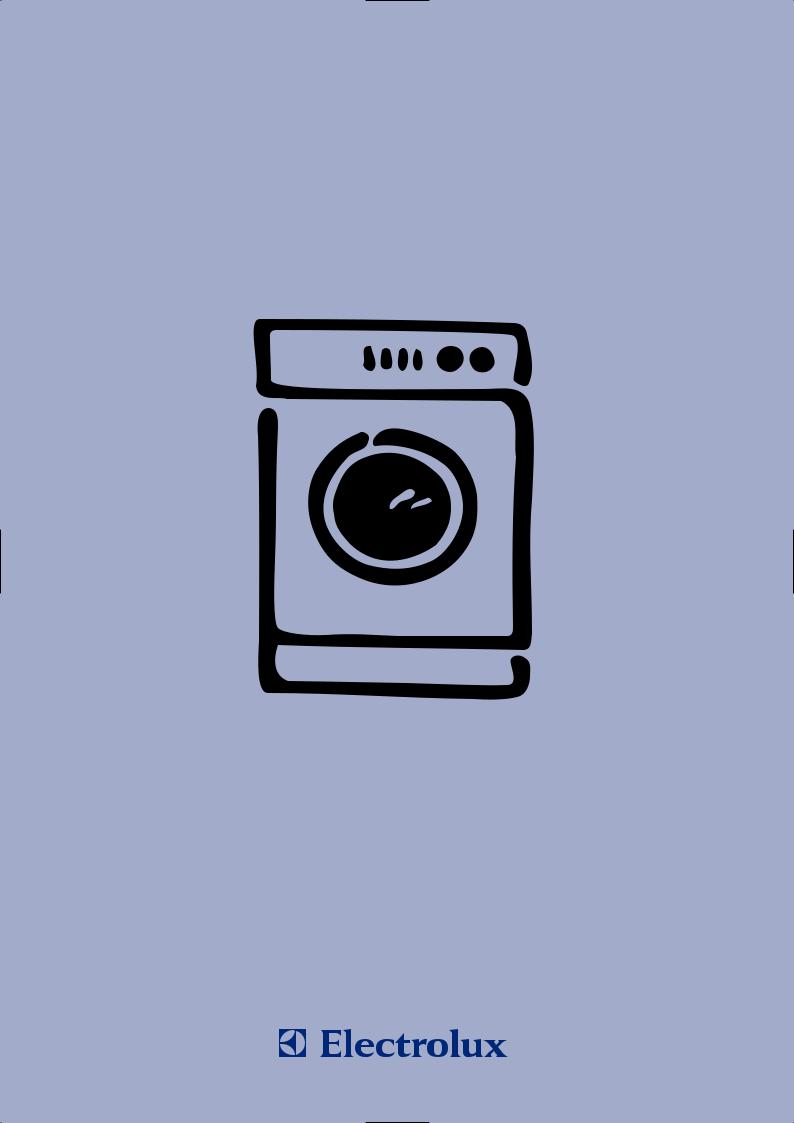
WASHER - DRYER
INSTRUCTION BOOKLET
EWD 1477
“Wash n Dr y Combo”
132 973 270

Dear customer,
Please read these operating instructions carefully and pay particular attention to the safety notes indicated in the first pages. We recommend that you keep this instruction booklet for future reference and pass it on to any future owners.
Transport damages
When unpacking the appliance, check that it is not damaged. If in doubt, do not use it and contact the Service Centre.
The symbols you will see on some paragraphs of this booklet have the following meaning:
The warning triangle and/or the key words (Warning!, Caution!) emphasize information that is particularly important for your safety or correct functioning of the appliance.
The information marked with this symbol provides additional instructions and practical tips on the use of the appliance.
 Tips and information about economical and ecological use of the machine are marked with this symbol.
Tips and information about economical and ecological use of the machine are marked with this symbol.
Our contribution to the protection of the environment: we use environmentally friendly paper.
2

Contents
Warnings |
4-5 |
Disposal |
5 |
Tips for environmental protection |
5 |
Operating sequence |
18-21 |
Washing programmes |
22-23 |
Timed drying |
24 |
International wash code symbols |
25 |
Technical specifications |
6 |
Maintenance |
26 |
|
Door seal |
26 |
|||
|
|
|||
Installation |
7 |
Bodywork |
26 |
|
Unpacking |
7 |
Detergent dispenser drawer |
26 |
|
Drain pump |
26-27 |
|||
Positioning |
7 |
|||
Water inlet filter |
27 |
|||
Water inlet |
7 |
|||
Emergency emptying out |
27 |
|||
Water drainage |
8 |
|||
Frost precautions |
27 |
|||
Electrical connection |
8 |
|||
|
|
|||
Your new washer-dryer |
9 |
Something not working? |
28-29 |
|
|
|
|||
Description of the appliance |
9 |
Electrolux Warranty |
30 |
|
Detergent dispenser drawer |
9 |
|
|
|
Use |
10 |
|
|
|
Control panel |
10 |
|
|
|
Controls |
10-13 |
|
|
|
Programme information |
14 |
|
|
|
Washing hints |
15 |
|
|
|
Sorting the laundry |
15 |
|
|
|
Temperatures |
15 |
|
|
|
Before loading the laundry |
15 |
|
|
|
Maximum loads |
15 |
|
|
|
Laundry weights |
15 |
|
|
|
Removing stains |
15 |
|
|
|
Detergents and additives |
16 |
|
|
|
Drying hints |
17 |
|
|
|
Load |
17 |
|
|
|
Garments not suitable for drying |
17 |
|
|
|
Drying symbols on garment labels |
17 |
|
|
|
Duration of the drying cycle |
17 |
|
|
|
Fibre residue |
17 |
|
|
|
Additional drying |
17 |
|
|
3

 Warnings
Warnings
The following warnings are provided in the interests of overall safety. You must read them carefully before installing or using the appliance.
Installation
•All internal packing must be removed before using the appliance. Serious damage may be caused to the machine or adjacent furniture if the protective transit devices are not removed or are not completely removed. Refer to the relevant paragraph in the instruction book.
•Any electrical work required to install this appliance must be carried out by a qualified electrician.
•Any plumbing work required to install this appliance must be carried out by a qualified plumber.
•After having installed the machine, check that it is not standing on its electrical supply cable.
•If the appliance is placed on a carpeted floor, ensure that air can circulate freely between the bottom of the unit and the floor.
•The appliance must not be installed behind a lockable door, a sliding door or a door with a hinge on the opposite side to that of the washer-dryer in such a way that a full opening of the washer-dryer door is restricted.
•Adequate ventilation must be provided to avoid the back flow of gases into the room from appliances burning other fuels, including open fires.
•Place small items such as socks, belts, etc. in a cloth bag or pillowcase to prevent them getting trapped between the drum and the tub.
•If you use a liquid detergent with a dispenser which has to be placed directly in the drum, remember to remove this dispenser before drying.
•Use only the recommended quantities of fabric softener and detergent. An excessive amount could damage the laundry or machine.
•Leave the porthole door slightly ajar when the appliance is not in use. This preserves the door seal and prevents the formation of musty smells.
•Always check that water has emptied out before opening the door. If not, drain the water following the instructions in the instruction book.
•Clean the lint trap after every cycle. Lint must not be allowed to accumulate around the unit, ensure the area is kept clean of lint.
•Always unplug the appliance and shut the water tap after use.
General safety
•Repairs to the machine must be carried out only by qualified personnel. Repairs carried out by inexperienced persons could cause serious danger. Contact your local Service Centre.
Use
•This appliance is designed for domestic use. It must not be used for purposes other than those for which it was designed.
•Only wash and dry fabrics which are designed to be machine washed and dried. Follow the instructions on each garment label.
•Do not overload the appliance. Follow the instructions in the instruction book.
•Make sure that all pockets are empty. Objects such as coins, safety pins, pins and screws can cause extensive damage.
•Do not machine wash garments saturated with petroleum, methylated spirits, trichlorethylene, etc. If such fluids have been used to remove stains prior to washing, wait until they have completely evaporated from the fabric before placing garments in the appliance.
•The washer-dryer is not to be used if industrial chemicals have been used for cleaning.
•Never pull the power supply cable to remove the plug from the socket; always take hold of the plug itself.
•During high temperature wash programmes and during the drying cycle the door glass may get hot. Do not touch it!
To minimize the risk of fire in a washer-dryer, following should be observed:
•Items that have been spotted or soaked with vegetable or cooking oil constitute a fire hazard and should not be placed in a tumble dryer. Oil-affected items can ignite spontaneously, especially when exposed to heat sources such as in a washer-dryer. The items become warm, causing an oxidation reaction in the oil. Oxidation creates heat. If the heat cannot escape, the items can become hot enough to catch fire. Piling, stacking or storing oil-affected items can prevent heat from escaping and so create a fire hazard.
4
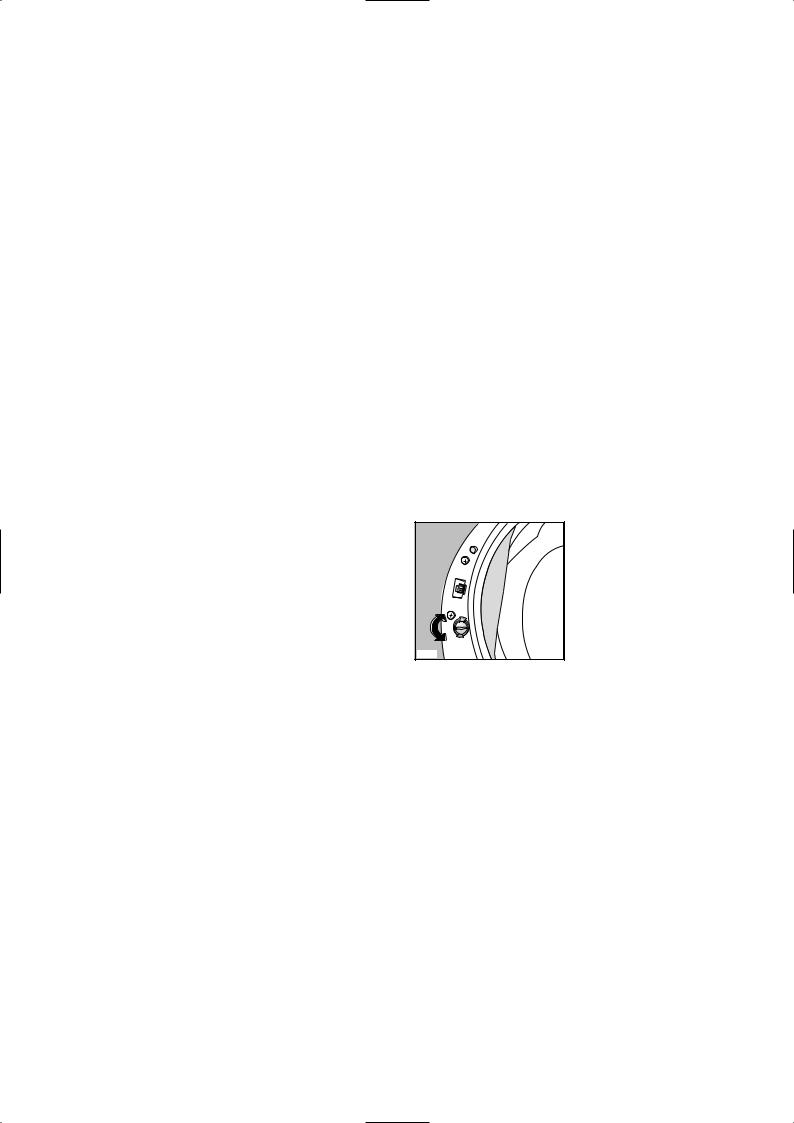
If it is unavoidable that fabrics that contain vegetable or cooking oil or have been contaminated by hair care products be placed in a waher-dryer they should first be washed in hot water with extra detergent - this will reduce, but not eliminate, the hazard.
The ‘cool down’ cycle of washer-dryers should be used to reduce the temperature of the items. They should not be removed from the washer-dryer or piled or stacked while hot.
•Items that have been previously cleaned in, washed in, soaked in or spotted with petrol/gasoline, dry-cleaning solvents or other flammable or explosive substunces should not be placed in a washer-dryer.
Highly flammable substances commonly used in domestic environments include acetone, denatured alcohol, petrol/gasoline, kerosine, spot removers (some brands), turpentine, waxes and wax removers.
•Items containing foam rubber (also known as latex foam) or similarly textured rubber, like materials should not be dried in a washer-dryer on a heat setting.
Foam rubber materials can, when heated, produce fire by spontaneous combustion.
•Fabric softeners or similar products should not be used in a washer-dryer to eliminate the effects of static electricity unless this practice is specifically recommended by the manufacturer of the fabric softener or product.
•Undergarments that contain metal reinforcements should not be placed in a washer-dryer.
Damage to the washer-dryer can result if metal reinforcements come loose during drying. When available a drying rack could be used for such items.
•Plastic articles such as shower caps or babies’ waterproof napkin covers should not be placed in a washer-dryer.
•Rubber-backed articles, clothes fitted with foam rubber pads, pillows, galoshes and rubber-coated tennis shoes should not be placed in a washerdryer.
Child safety
•This appliance is not intended for use by young children or infirm persons unless they have been adequately supervised by a responsible person to ensure that they can use the appliance safety. Young children should be supervised to ensure that they do not play with the appliance.
•The packaging components (e.g. plastic film, polystyrene) can be dangerous to children - danger of suffocation! Keep them out of children’s reach.
•Keep all detergents in a safe place out of children’s reach.
•Make sure that children or pets do not climb into the drum. To avoid this the machine incorporates a special feature. To activate this device, rotate the button (without pressing it) inside the door clockwise until the groove is horizontal. If necessary use a coin.
To disable this device and restore the possibility of closing the door, rotate the button anti-clockwise until the groove is vertical.
P1131 |
•When the appliance is to be scrapped, cut off the electrical supply cable and destroy the plug with the remaining cable. Disable the door catch in order to prevent children from becoming trapped inside while playing.
5

 Disposal
Disposal
Packaging materials
The materials marked with the symbol  are recyclable.
are recyclable.
>PE<=polyethylene >PS<=polystyrene >PP<=polypropylene
This means that they can be recycled by disposing of them properly in appropriate collection containers.
Machine
Use authorised disposal sites for your old appliance. Help to keep your country tidy!
The symbol  on the product or on its packaging indicates that this product should not be treated as household waste. Instead it should be handed over to the applicable collection point for the recycling of electrical and electronic equipment. By ensuring this product is disposed of correctly, you will help prevent potential negative consequences for the environment and human health, which could otherwise be caused by inappropriate waste handling of this product. For more detailed information about recycling of this product, please contact your local city office, your household waste disposal service or the shop where you purchased the product.
on the product or on its packaging indicates that this product should not be treated as household waste. Instead it should be handed over to the applicable collection point for the recycling of electrical and electronic equipment. By ensuring this product is disposed of correctly, you will help prevent potential negative consequences for the environment and human health, which could otherwise be caused by inappropriate waste handling of this product. For more detailed information about recycling of this product, please contact your local city office, your household waste disposal service or the shop where you purchased the product.
 Tips for environmental protection
Tips for environmental protection
To save water, energy and to help protect the environment, we recommend that you follow these tips:
•Normally soiled laundry may be washed without prewashing in order to save detergent, water and time (the environment is protected too!).
•The machine works more economically if it is fully loaded (for both washing and drying cycles).
•The machine will consume less energy if the laundry is adequately spun before being dried.
•With adequate pre-treatment, stains and limited soiling can be removed; the laundry can then be washed at a lower temperature.
•Measure out detergent according to the water hardness, the degree of soiling and the quantity of laundry being washed, following the detergent manufacturers instructions.
Technical specifications
DIMENSIONS |
Height |
85 cm |
|
|
Width |
60 cm |
|
|
Depth |
63 cm |
|
|
|
|
|
|
|
WASHING |
DRYING |
MAXIMUM LOAD |
Cotton |
7 kg |
3.5 kg |
|
Synthetics |
3.kg |
2 kg |
|
Delicates |
3.kg |
- |
|
Woollens/Handwash |
2 kg |
- |
|
|
|
|
SPIN SPEED |
|
1400 rpm max. |
|
|
|
||
POWER SUPPLY VOLTAGE/FREQUENCY |
220-240 V/50 Hz |
||
TOTAL POWER ABSORBED |
|
2050 W |
|
MINIMUM FUSE PROTECTION |
|
10 A |
|
|
|
|
|
WATER PRESSURE |
Minimum |
0.05 MPa |
|
|
Maximum |
0.8 MPa |
|
This appliance complies with the following EEC Directives: 73/23/EEC of 19/02/73 relating to low voltage
89/336/EEC of 03/05/89 relating to electromagnetic compatibility.
6
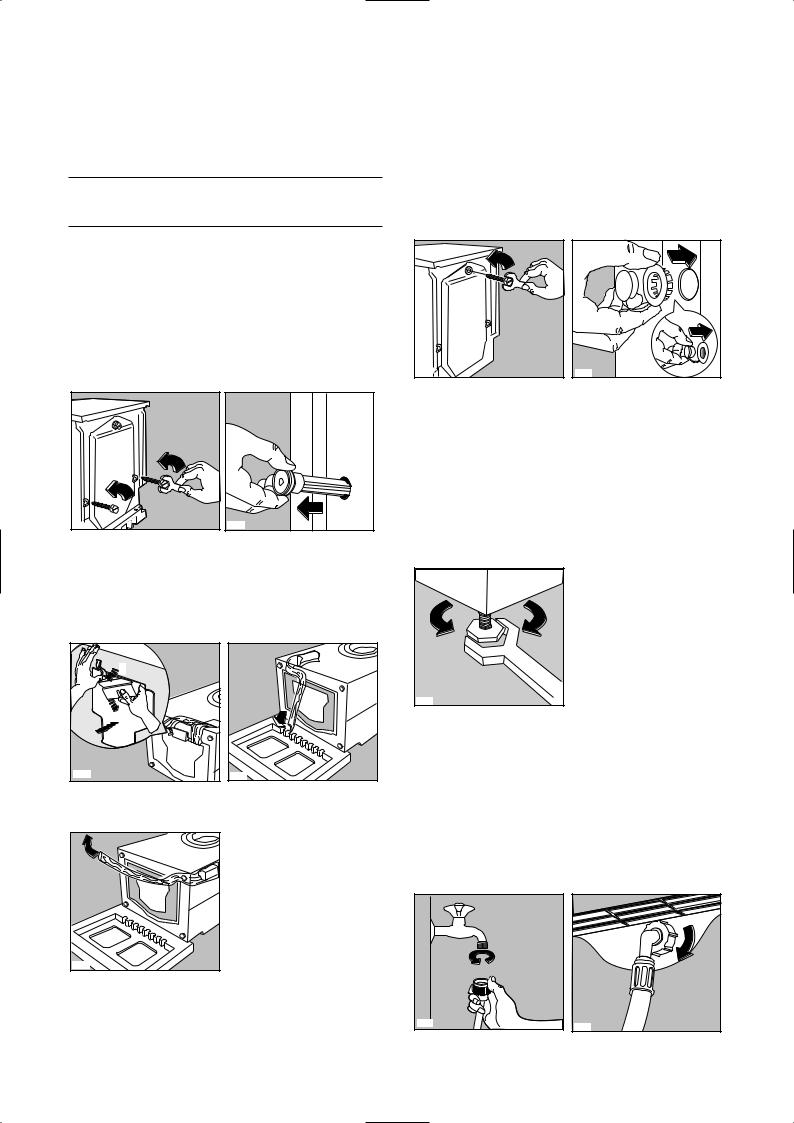
Installation
Unpacking
 All transit bolts and packing must be removed before using the appliance.
All transit bolts and packing must be removed before using the appliance.
You are advised to keep all transit devices so that they can be refitted if the machine ever has to be transported again.
1.Using a spanner, unscrew and remove the two rear bottom screws. Slide out the two plastic pins. Lay the machine on its back, taking care not to squash the hoses. This can be avoided by placing one of the corner packing pieces between the machine and the floor.
P1129 |
P0001 |
2.Remove the polystyrene block(s) from the bottom of the machine and release the two plastic bags.
3.Very carefully slide out the left polythene bag, removing it towards the right and then downwards.
1 |
P1124 |
P1126 |
4.Very carefully slide out the right polythene bag, removing it towards the left and then upwards.
P1127 |
5.Set the machine upright and remove the remaining rear screw. Slide out the relevant pin.
6.Plug all the holes with the plugs which you will find in the envelope containing the instruction manual.
P1128 |
P0002 |
Positioning |
|
Install the machine on a flat hard floor.
Make sure that air circulation around the machine is not impeded by carpets, rugs etc. Check that the machine does not touch the wall or cupboard units. Carefully level by screwing the adjustable feet in or out. Never place cardboard, wood or similar materials under the machine to compensate for any unevenness in the floor.
P1051 |
Water inlet
Connect water inlet hose to a COLD WATER TAP ONLY with 3/4” BSP thread.
Use the hose supplied with the washing machine. DO NOT USE OLD HOSES.
The other end of the inlet hose which connects to the machine can be turned in any direction. Simply loosen the fitting, rotate the hose and retighten the fitting, making sure there are no water leaks.
P1088 |
P0021 |
7
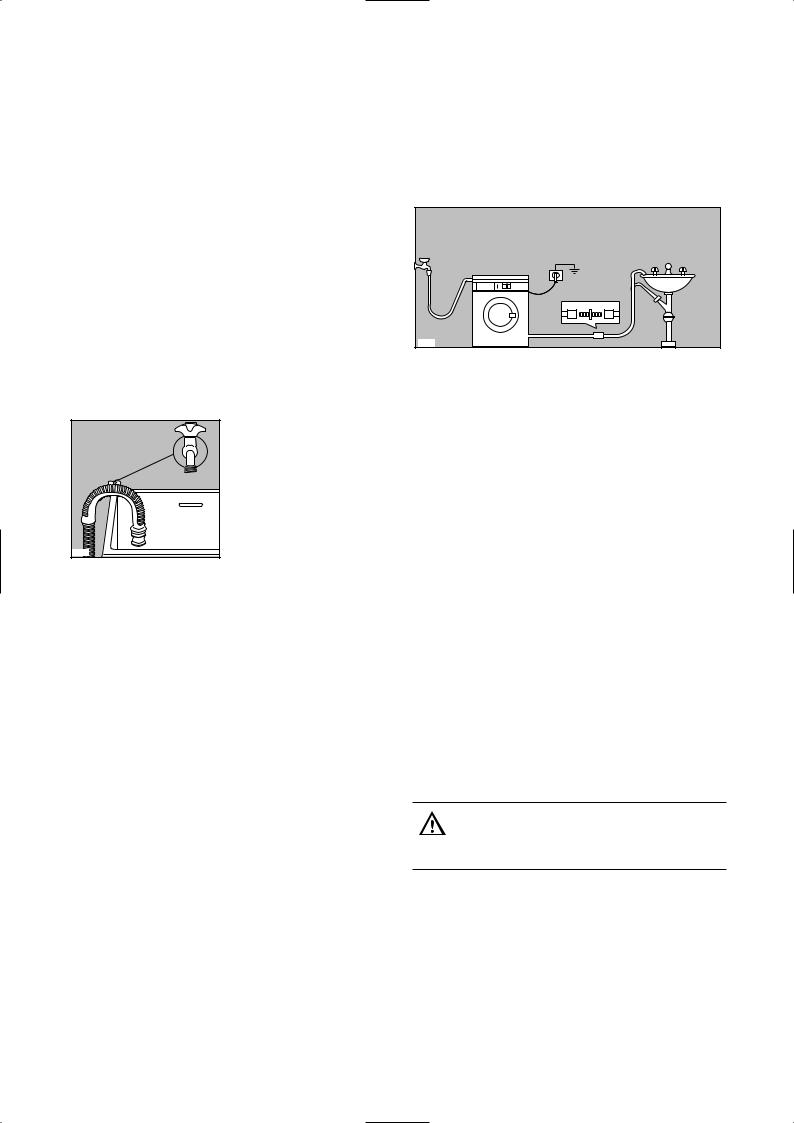
The inlet hose must not be lengthened. If it is too short and you do not wish to move the tap, you will have to purchase a new, longer hose specially designed for this type of use.
Water drainage
The end of the drain hose can be positioned in four ways:
Hooked over the edge of a sink using the plastic hose guide supplied with the machine. In this case, make sure the end cannot come unhooked when the machine is emptying.
This could be done by tying it to the tap with a piece of string or attaching it to the wall.
P0022 |
In a sink drain pipe branch. This branch must be above the tap so that the bend is at least 60 cm above the ground.
Directly into a drain pipe at a height of not less than 60 cm and not more than 90 cm.
The end of the drain hose must always be ventilated, i.e. the inside diameter of the drain pipe must be larger than the outside diameter of the drain hose.
Floor drain: the washing machine should be installed where a floor drain or hole is located (depending on plumbing regulations). A floor drain is required to drain away water which may overflow from the washing machine due to a hose leak or malfunction.
The drain hose must not be kinked. Run it along the floor; only the part near the drainage point must be raised.
P0023 |
The drain hose may be extended to a maximum of 4 metres. An additional drain hose and joining piece is available from your local Service Centre.
Electrical connection
This machine is designed to operate on a 220-240 V, single-phase, 50 Hz supply.
“An incorrect power supply may void your warranty”.
Check that your domestic electrical installation can take the maximum load required (2.2 kW), also taking into account any other appliances in use.
Connect the machine to an earthed socket.
IT IS STRONGLY RECOMMENDED NOT TO USE AN EXTENSION CORD OR ELECTRICAL PORTABLE OUTLET DEVICE.
CAUTION !
If the appliance is supplied from a cord extension set or an electrical portable outlet device, the cord extension set or electrical portable outlet device must be positioned so that it is not subject to splashing or ingress of moisture.
The manufacturer declines any responsibility for damage or injury through failure to comply with the above safety precaution.
IMPORTANT!
If the electrical cord of this appliance is damaged, it must be replaced by the Manufacturer, Authorised Service Agent or similarly qualified person in order to avoid a hazard.
8
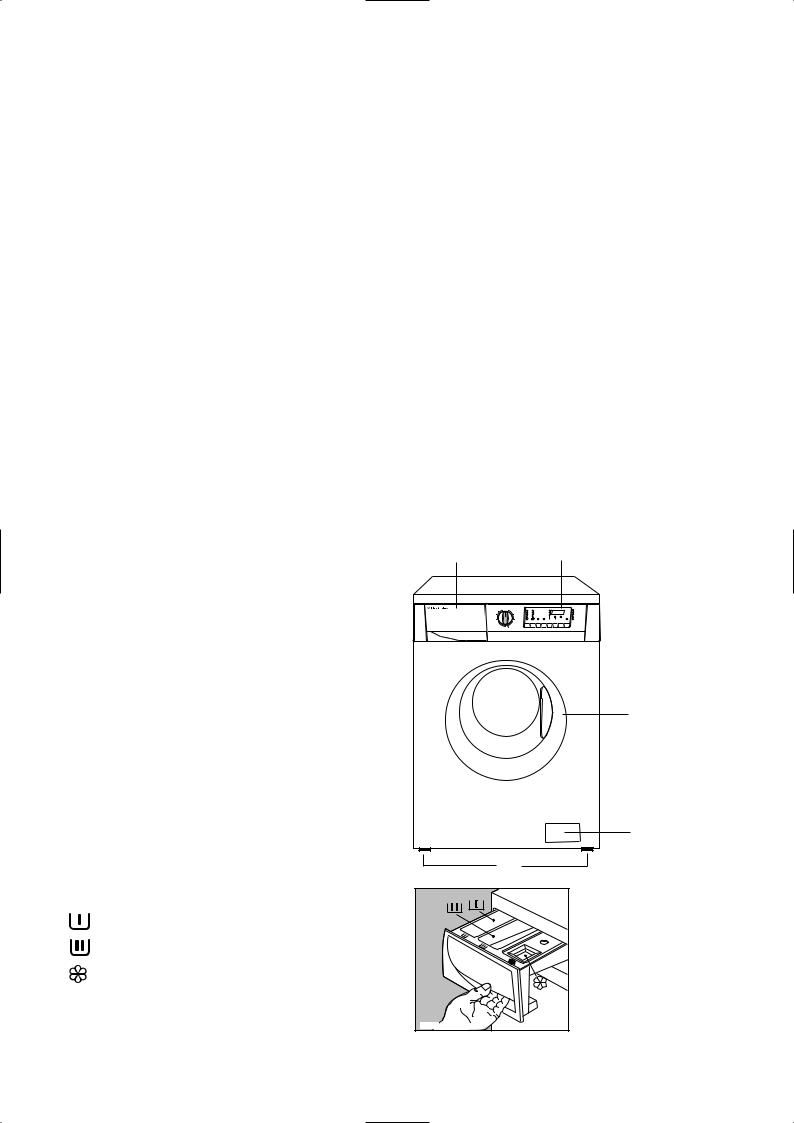
Your new washer-dryer
This new machine, which is fitted with the new Jet System, meets all modern needs for effective treatment of laundry with low water, energy and detergent consumption.
Further savings are achieved by washing small loads of laundry, since water and electricity consumption is proportional to the quantity and type of laundry being washed.
•The possibility of selecting the temperature, spin speed and all options offered by this machine gives you truly “customised” washing.
•The DELAY START option allows you to delay starting of the wash programme to the desired time of day.
•The RINSE HOLD function  (stop with water in drum) can be selected for all fabrics: the laundry is left immersed in the final rinse water to avoid the formation of creases.
(stop with water in drum) can be selected for all fabrics: the laundry is left immersed in the final rinse water to avoid the formation of creases.
•The programme progress display shows the programme steps selected and the programme phase which is running.
•The special wool programme with its new delicate wash system treats your woollens with extreme care.
•The drying programmes will give your wash that soft, relaxed feel whatever the weather.
•3-compartment drawer for convenient detergent and fabric softener dispensing.
•The balance control device ensures the machine is stable during the spin.
Description of the appliance
1 Detergent dispenser drawer
2 Control panel
3 Door handle
4 Drain pump
5 Adjustable feet
Detergent dispenser drawer
Prewash
Main wash
Fabric softener, starch
1 |
2 |
WASH n DRY COMBO KG / 3.5 KG |
|
7 |
|
|
3 |
|
4 |
|
5 |
C0063 |
9
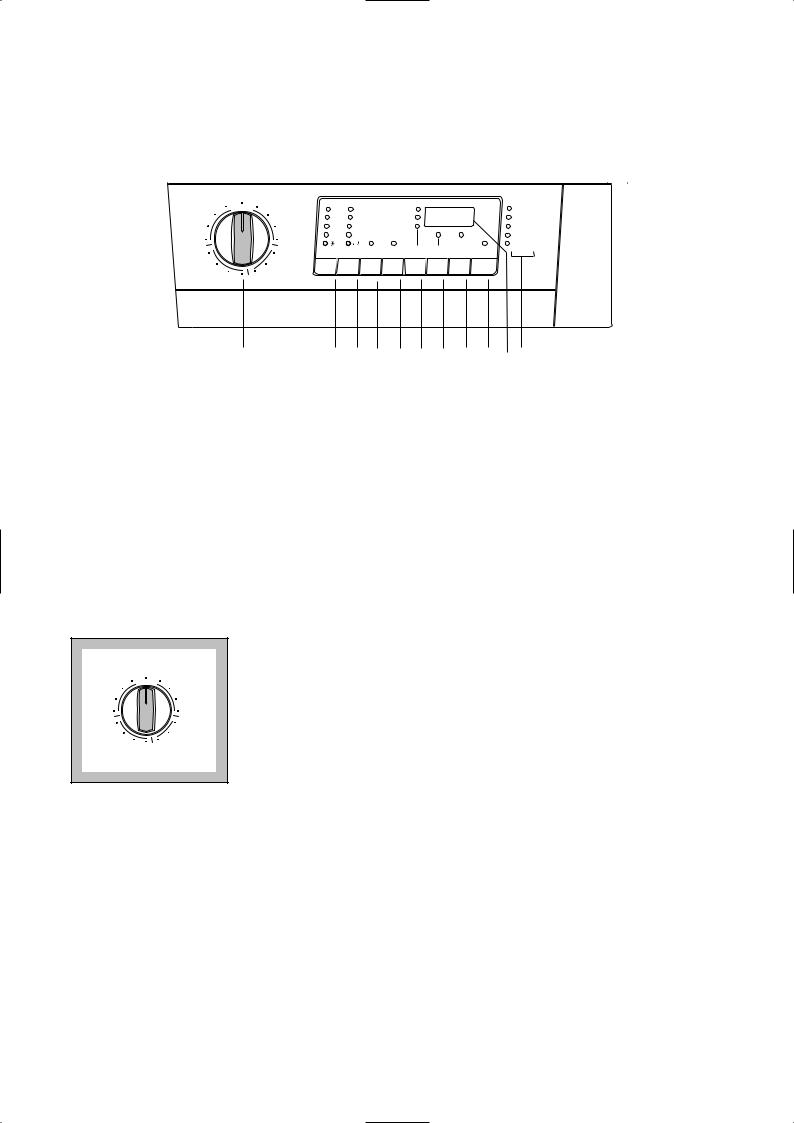
Use
Control panel
COTTONS
Delicate Spin |
Off |
Whites / Intensive |
|
|
|
|
|
|
|
|
|
95° |
|
1400 |
|
|
|
|
Prewash/Wash |
||
Spin |
|
Colourfast |
|
Extra Dry |
|
|
||||
|
60° |
|
1200 |
Store Dry |
|
|
Rinses |
|||
|
|
|
|
|
|
|||||
Drain |
|
Normal Eco |
40° |
|
900 |
Iron Dry |
|
|
Spinning |
|
Rinses |
|
Dry Only |
30° |
|
700 |
|
|
|
|
Drain |
|
|
|
|
|
|
|
|
Drying |
||
|
|
|
|
|
|
|
|
|
|
|
Quick 30 |
|
Synthetics |
|
|
|
Extra |
Auto |
Timed |
Delay |
Start/ |
|
Temp. |
Spin |
Prewash |
Rinse |
Dry |
Dry |
Start |
Pause |
||
Wool |
|
Normal Eco |
|
|
|
|
|
|
|
|
Handwash |
Delicate |
Dry Only |
|
|
|
|
|
|
|
|
SPECIAL |
SYNTHETICS |
|
|
|
|
|
|
|
EWD 1477 |
|
|
|
|
|
|
|
|
|
|||
1 2 3 4 5 6 7 8 91011
1 Programme selector dial
The programme selector dial is divided into the following sections:
•Cottons (Whites/ Coloureds),
•Synthetics,
•Delicate,
•Wool,
•Handwash,
•Special programmes from “Quick 30” to “Delicate Spin”
•Off = Reset programme/Switching the machine
|
|
COTTONS |
|
Delicate Spin |
Off |
Whites / Intensive |
|
|
|||
Spin |
|
Colourfast |
|
Drain |
|
Normal Eco |
|
Rinses |
|
Dry Only |
|
Quick 30 |
|
Synthetics |
|
Wool |
|
Normal Eco |
|
Handwash |
Delicate |
Dry Only |
|
SPECIAL |
SYNTHETICS |
||
|
The selector dial can be turned either clockwise or anticlockwise to select the required wash and drying programme .
Positions “Normal Eco” (Cottons) and “Normal Eco” (Synthetics) correspond to the ENERGY SAVING programmes.
Position “Dry only” corresponds to the drying programme.
Before setting the dial to any position ensure that the machine is switched off.
Important!
At the end of the programme the selector dial must be turned to position Off.
2 “Temp.” button
Press this button repeatedly to increase or decrease the temperature, if you want your laundry to be washed at a temperature different from the one proposed by the machine. The relevant light will light up.
Maximum temperatures are 95°C for White cottons, 60°C for Coloured cottons, Cottons Eco and Synthetic fabrics, 40°C for Synthetics Eco, Delicate fabrics, Wool and Handwash, 30°C for Quick 30.
Position  corresponds to a COLD WASH. This option can be used for very delicate laundry, such as curtains.
corresponds to a COLD WASH. This option can be used for very delicate laundry, such as curtains.
3 Spin speed button
Press this button repeatedly to change the spin speed, if you want your laundry to be spun at a speed different from the one proposed by the machine. The relevant light will light up. Maximum speeds are:
•for cotton: 1400 rpm;
•for synthetic fabrics, wool and handwash: 900 rpm;
•for delicate fabrics and “Quick 30” programme: 700 rpm.
RINSE HOLD position  : when you choose this option, the machine will not drain the water of the last rinse, so as not to wrinkle the laundry.
: when you choose this option, the machine will not drain the water of the last rinse, so as not to wrinkle the laundry.
At the end of the cycle, the light of the “Start/Pause” button goes out, the pilot light  remains lit, the door is blocked and a blinking zero will appear on the display to indicate that the water must be drained.
remains lit, the door is blocked and a blinking zero will appear on the display to indicate that the water must be drained.
10
